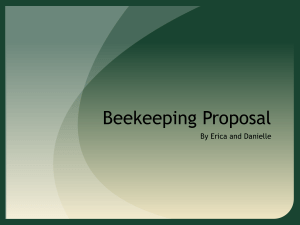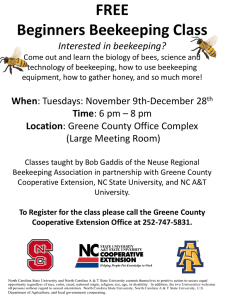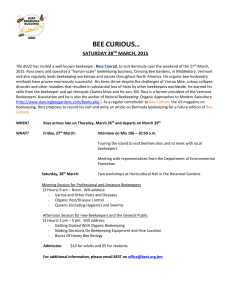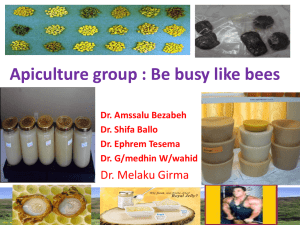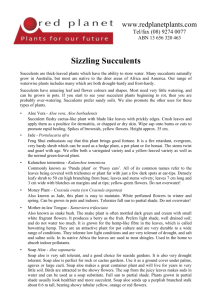Gender in Value Chains
advertisement
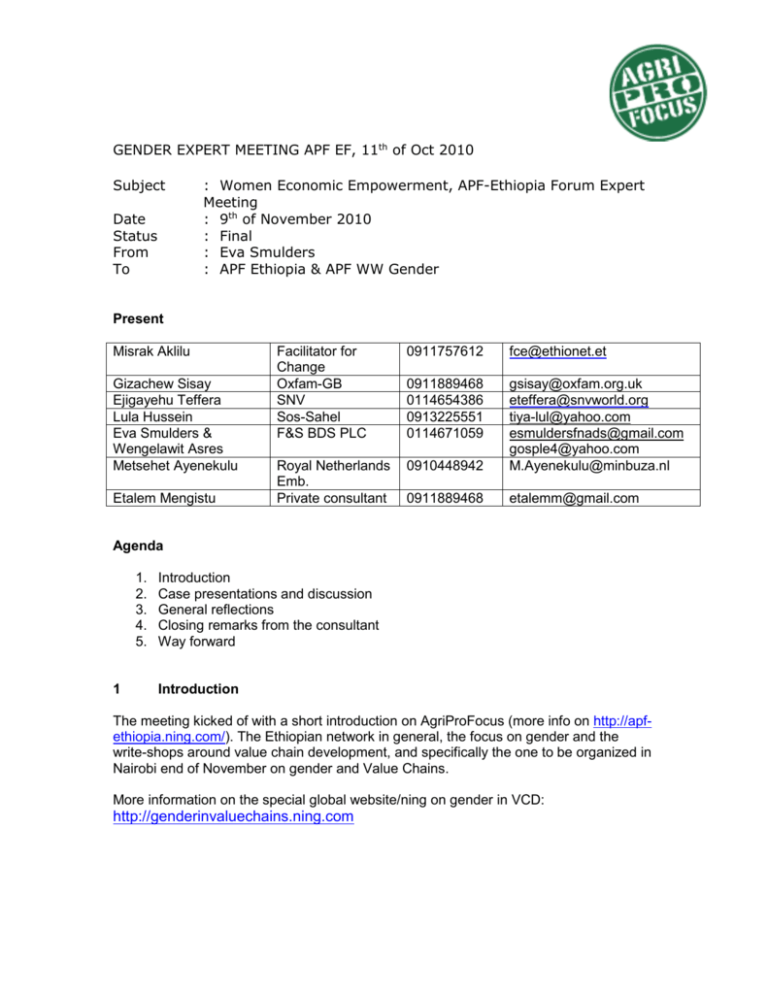
GENDER EXPERT MEETING APF EF, 11th of Oct 2010 Subject Date Status From To : Women Economic Empowerment, APF-Ethiopia Forum Expert Meeting : 9th of November 2010 : Final : Eva Smulders : APF Ethiopia & APF WW Gender Present Misrak Aklilu Gizachew Sisay Ejigayehu Teffera Lula Hussein Eva Smulders & Wengelawit Asres Metsehet Ayenekulu Etalem Mengistu Facilitator for Change Oxfam-GB SNV Sos-Sahel F&S BDS PLC 0911757612 fce@ethionet.et 0911889468 0114654386 0913225551 0114671059 Royal Netherlands Emb. Private consultant 0910448942 gsisay@oxfam.org.uk eteffera@snvworld.org tiya-lul@yahoo.com esmuldersfnads@gmail.com gosple4@yahoo.com M.Ayenekulu@minbuza.nl 0911889468 etalemm@gmail.com Agenda 1. 2. 3. 4. 5. 1 Introduction Case presentations and discussion General reflections Closing remarks from the consultant Way forward Introduction The meeting kicked of with a short introduction on AgriProFocus (more info on http://apfethiopia.ning.com/). The Ethiopian network in general, the focus on gender and the write-shops around value chain development, and specifically the one to be organized in Nairobi end of November on gender and Value Chains. More information on the special global website/ning on gender in VCD: http://genderinvaluechains.ning.com 2 Case Presentations All participants presented the cases, which they proposed for the value chain write shop in Nairobi. Below a short overview of the cases and the main discussion points. 2.1 Soybean VC from bean to milk by Facilitator for Change Main issues on the presentation The Value Chain project area is Jimma, Kersa. Females are highly participating in the soybean value chain on different levels Smallholder farmers (production function), Farmers Marketing Organizations (Collecting, cleaning and packing function), Women Cluster Level Associations (Processing function) Temki PLC (Distribution) Hospital, Cafe and Universities (Consumption) To specify on the different levels: Gender at Household level: 400 farmers involved (65 females) in soybean production for which 215 ha land is covered Women farmers were trained on soybean agronomic practices and food preparation techniques The initiative has improved access to and control over resources (soybean product) of married rural women through high involvement in local markets and FMOs. The initiative is linked to the Women Self Help Groups of the three districts through organizing food preparation trainings and food exhibition. It improved the nutritional problem of the children and the community. Gender at Farmer Market organization level Five FMOs that have legal entity are selected for the purpose It supports the participation of women (both in quantity and quality) at the Farmers Organizations Level to benefit them equally with men counterparts. 15% increase in participation of female at membership position as a result of sensitization and bylaw revision (double membership of bothhusband and wife) Gender at CLA One strong CLAs consisting of 165 mothers is linked to FMOs. The CLA is engaged in soybean processing (soybean milk production) The poor women of Jimma town who are organized in the Cluster Level Association (CLA) have improved their livelihood through better income by the Service Enterprise and Market Development initiative of the program. Main questions and observations: Because of cultural barrier (it’s mainly a Muslim area) there is a problem on female participation in the value chain. o The revision of the by-laws has helped to increase female participation and membership in the organizations. To give them a role in the processing the participation of women improved, but still in the production of the soya bean the males are dominant. o The approach is mostly on Female, especially it includes poor women 2.2 Honey VC women leadership Oxfam GB – Case selected for writeshop Main issues in the presentation: The issue of gender in Oxfam is non-negotiable We put women at the heart of our work (be it humanitarian, development or policy) Recently Oxfam adopted Gendered value chain approach where the role, participation, leadership and benefit of women in the whole chain is analyzed. Key questions How do men & women engage in and benefit differently from these VC markets? In which areas of the market map are women concentrated? Beyond numbers of men and women – what institutions, companies, policies and practices are more inclusive or exclusive of women smallholders? Accordingly programs are designed Honey and wax are high potential crops, but some problems encountered for women entrepreneurship: Beekeeping is considered as men’s function (women are not considered as BKs) b/c Hives are kept on the trees Afraid bee sting Do not have skill & know-how & lack access to tech & market Thus participation of women in the beekeeping sub-sector is insignificant (1%) 95% of the bee colonies are kept in traditional hives Even kept in back yard, the setting of traditional hive is not convenient for women to manage (sting etc) Productivity is low and quality is poor Still attractive and possible because: BK has strong potential for poverty reduction (income & employment generation for smallholders, mainly for women, landless and youth) Improved beekeeping technology will allow women to participate in production as well as marketing of honey. Can be done in spare time & at homestead where women can manage/engage BK doesn’t need land, labor and investment on inputs as compared to other agriculture activities (eg crop production) Government’s priority for the sub-sector is high Productivity & quality can be improved easily @ scale What was done: Gender was one of the criteria used in the selection of the commodity Identified key actors in the chain, the key levers for change, constraints and potentials to engage women, Oxfam’s facilitation role with due consideration of women Strategies to address gender related issue in the value chain o Participation of women reduces as we go up in the VC Interventions at each stage of the chain identified o Organizing women beekeepers into SHGs to access training, credit, inputs and market o Capacity building of women BKs (to transform their subsistent production into commercial & introduce FAL) o Facilitate linkage between producers and private sector o Plan to launch specialty honey marketing produced by Women BKs Sensitization of VC actors about issue of gender (how to engage women in the chain) Engage more women in the HVC stakeholders forums Interventions and achievements Through the interventions (training of women beekeepers on use of technology, provision of improved hives) the participation of women on beekeeping increased (from 1% to 17% in the piloting phase of the project) and now to 40% Usually husbands do not allow wives to travel long distance to attend trainings organized in towns. OGB with the private company (Ambrosia plc) has established beekeeping training and demonstration centre in the villages, which as a result 80 women beekeepers were trained. Now women beekeepers have learnt management of improved beehives and use of beekeeping tools and equipments. The materials and equipments have increased their confidence. For example the gloves and veil make them not to afraid beestings. On the other hand women have become active participants in the honey value chain by making accessories such as (veil, gloves, basket hives) and able to generate income in addition to the income from sale of honey. Case: Zenbu Melese, 58, female beekeeper and also treasurer of the Tana Zuria Bees’ products development and marketing cooperative, told her personal experience by emphasizing the importance of the cooperative. She said ‘before we were exposed to illegal traders. They didn’t even tell us the exact weight of the honey and they didn’t give us the right price. Now, because of the coop, we are getting the right price now and the dividend latter. We know and trust the people working in the coop, even if we didn’t read and write. There is no more traveling long distance and no risk of theft’. Challenges Social construct of thinking ‘men are beekeepers’ Capacity of producers in maintaining quality and supply Lack of product diversification (such as propolis and venom) Inability to benefit from large exports markets Environmental degradation It is transformed from traditional to Modern, which makes the access for women easier, but still there is a thinking men are Beekeeping Comments and input on how to present the case in Nairobi. Pls talk about the taboo for women to participate not giving the excuses as the main reason, like strength, fear for stings, these only make the focus worse Check the figures. Even these figures are from more a men’s way of looking at activities. Women DO participate but are not counted often bcz they are not ehad of the household for example. Go beyond the figures. Although women earn more how can we make sure they also have control over their earnings. Role of Oxfam GB very interesting as a facilitator Illiteracy seems to be the real bottleneck Funding still an issue for access. How to make sure you are making the new techniques accessible for women. 2.3 Honey VC women leadership – SNV in name of Rahi Mar PLC Main issues from the presentation First females were not accepted to go into the honey production, after convincing them, 20 women are started and engaged on Beekeeping. Rahel is one of them and:- She became capable - Self-confidence build - Installed processing plant - Chairperson - Market link - The women didn’t manage as expected Impact A large group of destitute women is on the way to becoming self-supporting Children who did not attend schools are doing so overall well-being has improved (visibly by better clothing and nutrition) Women beekeepers – diversified IGAs Beneficiaries (re) gained dignity A blue collar citizen become a visible apiculture investor Learnt lessons Bees can sting! But women can produce/use protective clothing after obtaining the training and started to use the protective cloth, the women regrettably say “If we had known this technique earlier, we would have been engaged in honey production even before now.” One does not need previous experience to be a good modern beekeeper but one needs substantial on the job experience Women beekeeper groups can be transformed into well organized women beekeepers’ associations International NGOs (as SNV did) can offer partnerships and linkages Challenges It was difficult to convince women The women as expected didn’t manage to become bee colony producers & to purchase more bee hives. Many people were discouraging Rahel for being involved in men’s work The work requires to travel frequently – she misses her family, safety issue, discomfort Less access to information Shy (less confidence as a leader) Lack of Financial resource Opportunities Good collaboration from government officials to give her land Previously owned piece of fenced land Very supportive and understanding family Linkages created SNV’s advisory service, financial & technical support Experience sharing in apiculture board or coordinating group meetings High demand for organic honey Main discussion topics How she manages the finance? She indeed needs working capital. In most women entrepreneur the major problem is finance, now we get loan guarantee for women. - Enat Bank – has promise for women Entrepreneur’s to give credit - USAID has a special program to promote women entrepreneurship. 2.4 Aloe Value Chain Soap Processing women in Diid yabelo SOS – Sahel SOS Sahel Ethiopia has been addressing women’s livelihood and economic needs within many of its programs and projects. It has got a grant from Oxfam Canada for the “Value Chain Empowerment through Women-Led Initiative of Pastoral Community of Borana” project are the poor households and women in Ade-Galchat, El-waye and Diid Yabelo villages in Yabelo District where highest concentration of the gum and incense source trees and aloe plant is found in abundance. About 700 households (with about 3500 household members) in the three villages are directly targeted for this intervention. The proposed intervention also target, private sector (local merchants and exporters), market cooperatives and local government staff that have been directly involved in nontimber forest products (NTFPs) harvesting and marketing including aloe soap, incense and gum/resin products. Thus, indirectly some potential members and other value chain actors like traders, inputs suppliers and potential co-operative members indirectly benefit from this project. Though many of these pastoralists would have been more transhumant in nature in the past, today they are settled or semi-settled and base their transhumance from a permanent household. Usually the husband will still travel with the livestock to find water and grazing, whilst the wife stays at home. The project trained the women led group to make soap, the pastoralist women has already started selling their product to the local market. Quality control Actions: Standardization: The cooperative should standardize its Aloe soap and ensure that it complies with government regulations. Packaging and labeling: the Aloe cooperatives should improve the soap Constrains or challenge Resource ownerships: the resource is owned communally but only few cooperative members are benefitting from it. Marketing of the Aloe soap due to other soap from Kenya and within Ethiopia. Product diversification: availability of soap with the different Aromas Quality control: The ingredient has to be fully and accurately measured and mixed properly with close supervision of quality control committee. Collaboration with quality control agency of Government to get advises on quality improvement. Lesson Learnt Involvement of all actors in the chain is crucial Danger of project phase out: the project might phase out before the impact of the cooperatives is seen Main discussion/ questions How does it relate to their pastoralist life style? This pastoralist are not moving with the entire family it’s more the father and/or youth that moves with the herd. Does Aloe have a market, customer need assessment and feed-back? Plan to bring the product to NGO market/exhibition. Food security When men move there are food scarcity for those behind. They now keep some life-stock and cultivation of smaller areas How the Soap is accepted Aloe is known traditionally so he community accept the product an introduce to others. And also they use as a medicine. They have a plan to promote the product on the AA market. 3 General reflections on the cases 4 We know better the participation and hard data of men’s participation or at least general number but we do not specifically have data on women participation in and around the VC and entrepreneurship. We need numbers that distinguish. Women have access through our special programs, but still the men have both access and control. Women are market players but only when small amounts are at stake, when the production or quantity sold grows the men take over. Women are more linked to the consumables and buy consumables from it. Men take the large quantities and are more of a collectors/traders Again the women purchase and the men are purchaser and supplier. New market or new commodity is easy to engage for women but on the existing system it is not easy. Still the women have little assets like land, savings, house, which makes them vulnerable. When value is added again, men in most cases take over. Closing remarks from the consultant Gender in Value Chain Development Gender analysis is generally the weakest point in most value chain analyses, and largely ignored in most value chain manuals. Gender differences and inequalities affect the ways in which value chains operate at every level. Women and men are likely to be involved at different stages of the chain as producers and entrepreneurs, in marketing and as consumers. Those areas where women are involved are often less visible and may be overlooked in both analysis and development. Information gap Participation of men and women in seed selection Number of men and women researchers Number of men and women extension workers Research information disseminations to men and women The amount of commodity allocated to home consumption How much cash is earned by men and women from sells of commodity How much of the cash is used by men and women for family and for personal use How much commodity is supplied by women to the market in a year In terms of receiving dividends the 15 to 28 %, members of the FMOs being women they would receive dividend on their shares , but how the income is used and who decides on how it is used with in the household needs a further assessment to be certain on how the intervention benefited women participants. Message is: be careful how you measure. Measure on time: have a baseline that is gender sensitive. Use methodologies that are gender sensitive in the VC approach 5 Way forward Oxfam GB will give a de-briefing after the write-shop (from 22 to 30th of November 2010). Next year a book launch will be organized which gives an opportunity to present and discuss more topics related to gender and VCD in a broader setting. Idea is to invite some successful businesswomen (in the Agricultural sector) in Ethiopia for a dinner and hear about their “way to the top”. There is a workshop Gender and Market-oriented Agriculture 2011 (AgriGender 2011): From Research to Practice 31st January-2nd February, 2011. Addis Ababa, Ethiopia, organized by ILRI.
